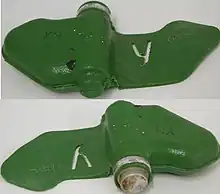U (Cyrillic)
U (У у; italics: У у) is a letter of the Cyrillic script. It commonly represents the close back rounded vowel /u/, somewhat like the pronunciation of ⟨oo⟩ in "boot" or "rule". The forms of the Cyrillic letter U are similar to the lowercase of the Latin letter Y (Y y; Y y), with the lowercase Cyrillic letter U's form being identical to that of small Latin letter Y.


| Cyrillic letter U | |||||||||||||||||||||||||||||||||||||||||||||||||||||||||||||||||||||||||||||||||||||||||||||||||||||||||||||||||||||||||||||||||||||||||||||||||||||||||||||||||||||||||||||||||||||||||||||||||||||||||||||||||
|---|---|---|---|---|---|---|---|---|---|---|---|---|---|---|---|---|---|---|---|---|---|---|---|---|---|---|---|---|---|---|---|---|---|---|---|---|---|---|---|---|---|---|---|---|---|---|---|---|---|---|---|---|---|---|---|---|---|---|---|---|---|---|---|---|---|---|---|---|---|---|---|---|---|---|---|---|---|---|---|---|---|---|---|---|---|---|---|---|---|---|---|---|---|---|---|---|---|---|---|---|---|---|---|---|---|---|---|---|---|---|---|---|---|---|---|---|---|---|---|---|---|---|---|---|---|---|---|---|---|---|---|---|---|---|---|---|---|---|---|---|---|---|---|---|---|---|---|---|---|---|---|---|---|---|---|---|---|---|---|---|---|---|---|---|---|---|---|---|---|---|---|---|---|---|---|---|---|---|---|---|---|---|---|---|---|---|---|---|---|---|---|---|---|---|---|---|---|---|---|---|---|---|---|---|---|---|---|---|---|
 | |||||||||||||||||||||||||||||||||||||||||||||||||||||||||||||||||||||||||||||||||||||||||||||||||||||||||||||||||||||||||||||||||||||||||||||||||||||||||||||||||||||||||||||||||||||||||||||||||||||||||||||||||
| Phonetic usage: | [u],[ʊ],[ʌ] | ||||||||||||||||||||||||||||||||||||||||||||||||||||||||||||||||||||||||||||||||||||||||||||||||||||||||||||||||||||||||||||||||||||||||||||||||||||||||||||||||||||||||||||||||||||||||||||||||||||||||||||||||
| Numeric value: | 400 | ||||||||||||||||||||||||||||||||||||||||||||||||||||||||||||||||||||||||||||||||||||||||||||||||||||||||||||||||||||||||||||||||||||||||||||||||||||||||||||||||||||||||||||||||||||||||||||||||||||||||||||||||
| Derived from: | Greek letter Upsilon (Υ υ) | ||||||||||||||||||||||||||||||||||||||||||||||||||||||||||||||||||||||||||||||||||||||||||||||||||||||||||||||||||||||||||||||||||||||||||||||||||||||||||||||||||||||||||||||||||||||||||||||||||||||||||||||||
| The Cyrillic script | |||||||||||||||||||||||||||||||||||||||||||||||||||||||||||||||||||||||||||||||||||||||||||||||||||||||||||||||||||||||||||||||||||||||||||||||||||||||||||||||||||||||||||||||||||||||||||||||||||||||||||||||||
| Slavic letters | |||||||||||||||||||||||||||||||||||||||||||||||||||||||||||||||||||||||||||||||||||||||||||||||||||||||||||||||||||||||||||||||||||||||||||||||||||||||||||||||||||||||||||||||||||||||||||||||||||||||||||||||||
| |||||||||||||||||||||||||||||||||||||||||||||||||||||||||||||||||||||||||||||||||||||||||||||||||||||||||||||||||||||||||||||||||||||||||||||||||||||||||||||||||||||||||||||||||||||||||||||||||||||||||||||||||
| Non-Slavic letters | |||||||||||||||||||||||||||||||||||||||||||||||||||||||||||||||||||||||||||||||||||||||||||||||||||||||||||||||||||||||||||||||||||||||||||||||||||||||||||||||||||||||||||||||||||||||||||||||||||||||||||||||||
| |||||||||||||||||||||||||||||||||||||||||||||||||||||||||||||||||||||||||||||||||||||||||||||||||||||||||||||||||||||||||||||||||||||||||||||||||||||||||||||||||||||||||||||||||||||||||||||||||||||||||||||||||
| Archaic or unused letters | |||||||||||||||||||||||||||||||||||||||||||||||||||||||||||||||||||||||||||||||||||||||||||||||||||||||||||||||||||||||||||||||||||||||||||||||||||||||||||||||||||||||||||||||||||||||||||||||||||||||||||||||||
| |||||||||||||||||||||||||||||||||||||||||||||||||||||||||||||||||||||||||||||||||||||||||||||||||||||||||||||||||||||||||||||||||||||||||||||||||||||||||||||||||||||||||||||||||||||||||||||||||||||||||||||||||
History
Historically, Cyrillic U evolved as a specifically East Slavic short form of the digraph ⟨оу⟩ used in ancient Slavic texts to represent /u/. The digraph was itself a direct loan from the Greek alphabet, where the combination ⟨ου⟩ (omicron-upsilon) was also used to represent /u/. Later, the o was removed, leaving the modern upsilon-only form.
Consequently, the form of the letter is derived from Greek upsilon ⟨Υ υ⟩, which was parallelly also taken over into the Cyrillic alphabet in another form, as Izhitsa ⟨Ѵ⟩. (The letter Izhitsa was removed from the Russian alphabet in the orthography reform of 1917/19.)
It is normally romanised as "u", but in Kazakh, it is romanised as "w".
In the Cyrillic numeral system, the Cyrillic letter U had a value of 400.
In other languages
In Tuvan the Cyrillic letter can be written as a double vowel.[1][2]
In certain languages, U is used to mark labialization.
Related letters and other similar characters

- Υ υ : Greek letter Upsilon
- U u : Latin letter U
- Y y : Latin letter Y
- Ў ў : Cyrillic letter Short U, used in Belarusian, Dungan,[3] Siberian Eskimo (Yuit), Uzbek
- Ӯ ӯ : Cyrillic letter U with macron, used in Tajik and Carpatho-Rusyn
- Ӱ ӱ : Cyrillic letter U with diaeresis, used in Altai (Oyrot), Khakas, Gagauz, Khanty, Mari
- Ӳ ӳ : Cyrillic letter U with double acute, used in Chuvash
- Ү ү : Cyrillic letter straight U, used in Mongolian, Kazakh, Tatar, Bashkir, Dungan and other languages
- Ұ ұ : Cyrillic letter Straight U with stroke, used in Kazakh
- Ꭹ Ꮍ : The syllables gi and mu of the Cherokee syllabary; Ꭹ (gi) notably appearing in the Cherokee self-designation ᏣᎳᎩ (Tsalagi)
- ע: The Hebrew letter Ayin
- У̊: Cyrillic letter U with ring,used in shugnhi orthography.
Computing codes
| Preview | У | у | ||
|---|---|---|---|---|
| Unicode name | CYRILLIC CAPITAL LETTER U | CYRILLIC SMALL LETTER U | ||
| Encodings | decimal | hex | dec | hex |
| Unicode | 1059 | U+0423 | 1091 | U+0443 |
| UTF-8 | 208 163 | D0 A3 | 209 131 | D1 83 |
| Numeric character reference | У | У | у | у |
| Named character reference | У | у | ||
| KOI8-R and KOI8-U | 245 | F5 | 213 | D5 |
| Code page 855 | 232 | E8 | 231 | E7 |
| Code page 866 | 147 | 93 | 227 | E3 |
| Windows-1251 | 211 | D3 | 243 | F3 |
| ISO-8859-5 | 195 | C3 | 227 | E3 |
| Macintosh Cyrillic | 147 | 93 | 243 | F3 |
References
- "Tuvan language, alphabet and pronunciation". omniglot.com. Retrieved 14 June 2016.
- Campbell, George L.; King, Gareth (24 July 2013). Compendium of the World's Languages. Routledge. ISBN 9781136258459. Retrieved 14 June 2016 – via Google Books.
- However, many Dungan books are set using Ӯ, with macron, instead of Ў, with breve, like the Dungan-Russian dictionary (1968). There is no ambiguity since it is the only У-with-a-diacritic in Dungan. It is used in Dungan syllables for which pinyin would use -u except in those with labial consonants (in du, ' nu, lu, gu, hu, zu, ru, etc. but not bu or mu)